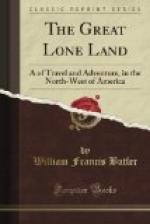Niagara—They have all had their say about Niagara. From Hennipin to Dilke, travellers have written much about this famous cataract, and yet, put all together, they have not said much about it; description depends so much on comparison, and comparison necessitates a something like. If there existed another Niagara on the earth, travellers might compare this one to that one; but as there does not exist a second Niagara, they are generally hard up for a comparison. In the matter of roar, however, comparisons are still open. There is so much noise in the world that analysis of noise becomes easy. One man hears in it the sound of the Battle of the Nile-a statement not likely to be challenged, as the survivors of that celebrated naval action are not numerous, the only one we ever had the pleasure of meeting having been stone-deaf. Another writer compares the roar to the sound of a vast mill; and this similitude, more flowery than poetical, is perhaps as good as that of the one who was in Aboukir Bay. To leave out Niagara when you can possibly bring it in would be as much against the stock-book of travel as to omit the duel, the steeple-chase, or the escape from the mad bull in a thirty-one-and-sixpenny fashionable novel. What the pyramids are to Egypt—what Vesuvius is to Naples—what the field of Waterloo has been for fifty years to Brussels, so is Niagara to the entire continent of North America.
It was early in the month of September, three years prior to the time I now write of, when I first visited this famous spot. The Niagara season was at its height: the monster hotels were ringing with song, music, and dance; tourists were doing the falls, and touts were doing the tourists. Newly-married couples were conducting themselves in that demonstrative manner characteristic of such as responded freely to the invitation contained in their favourite nigger melody. Venders of Indian bead-work; itinerant philosophers; camera-obscura men; imitation squaws; free and enlightened negroes; guides to go under the cataract, who should have been sent over it; spiritualists, phrenologists, and nigger minstrels had made the place their own. Shoddy and petroleum were having “a high old time of it,” spending the dollar as though that “almighty article had become the thin end of nothing whittled fine:” altogether, Niagara was a place to be instinctively shunned.
Just four months after this time the month of January was drawing to a close. King Frost, holding dominion over Niagara, had worked strange wonders with the scene. Folly and ruffianism had been frozen up, shoddy and petroleum had betaken themselves to other haunts, the bride strongly demonstrative or weakly reciprocal had vanished, the monster hotels were silent and deserted, the free and enlightened negro had gone back to Buffalo, and the girls of that thriving city no longer danced, as of yore, “under de light of de moon.” Well, Niagara was worth seeing then-and the less we say about it, perhaps, the better. “Pat,” said an American to a staring Irishman lately landed, “did you ever see such a fall as that in the old country?” “Begarra! I niver did; but look here now, why wouldn’t it fall? what’s to hinder it from falling?”




